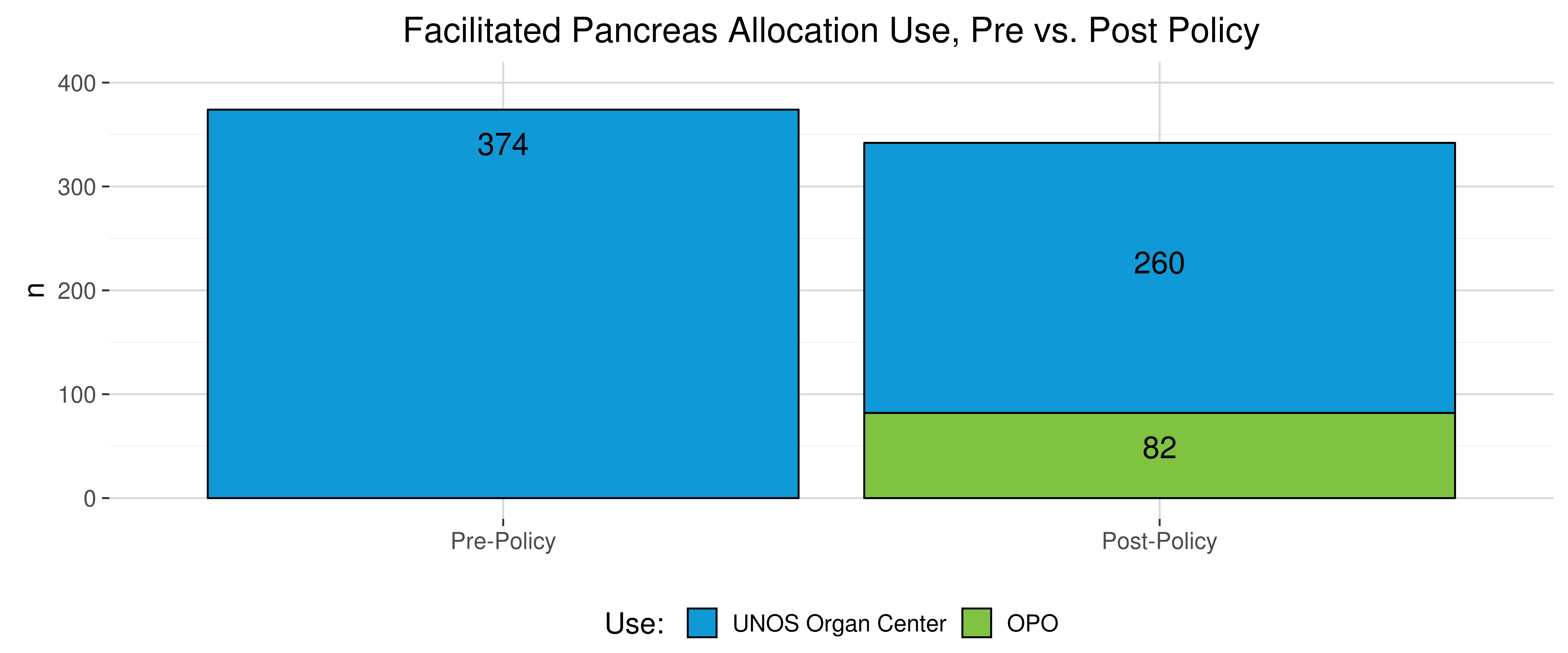Policy Changes in Facilitated Pancreas Allocation Support Pancreas Utilization
1United Network for Organ Sharing, Richmond, VA, 2Department of Surgery, University of Wisconsin-Madison School of Medicine and Public Health, Madison, WI, 3Department of Surgery, University of Maryland Medical Center, Baltimore, MD
Meeting: 2019 American Transplant Congress
Abstract number: 401
Keywords: Allocation, Pancreas, Pancreas transplantation
Session Information
Session Name: Concurrent Session: Pancreas and Islet: All Topics II
Session Type: Concurrent Session
Date: Monday, June 3, 2019
Session Time: 4:30pm-6:00pm
 Presentation Time: 4:42pm-4:54pm
Presentation Time: 4:42pm-4:54pm
Location: Room 209
*Purpose: In an effort to address the decline in pancreas transplantation, facilitated pancreas allocation (FPA) was modified August 16, 2016 from an opt-in system for transplant programs to metric based. Additionally, Organ Procurement Organizations (OPOs) are allowed to use FPA instead of only the OPTN Organ Center (OC). This analysis examines OPO and OC use of FPA post policy implementation.
*Methods: OPTN data from March 19th, 2015 through March 17th, 2018 were analyzed. Deceased donor data was used to calculate pancreas utilization rates to examine national trends. Offer data was aggregated to examine offer acceptance practices. A propensity score comprised of donor characteristics pertinent to pancreas utilization as well as recipient characteristics was used in 1-1 matching of post-policy FPA transplants with nonlocal, non-facilitated transplants. The matched cohort was used to compare differences in the sequence number for the acceptor as well as total preservation time.
*Results: Nationally, utilization rates declined consistently throughout the study period; 10.5% pre-policy compared to 9.8% post-policy (p: 0.03). FPA was used 342 times since policy implementation, compared to 374 pre-policy. Of the 342 FPA offers, 38 OPOs used the facilitated list 82 times. Post-policy, 21 transplants resulted from 342 FPA offers, with 4 transplants occurring directly from OPOs (19%). The average offer acceptance rate for pancreata transplanted using FPA was 14.8%, compared to 15.7% for nonlocal pancreata transplanted using the regular match (p: 0.87). Of facilitated offers that were not ultimately accepted, the most common refusal reasons were donor age or quality, multiple organ transplant required, and distance to travel or ship. The matched cohort of FPA transplants revealed no significant difference in the median sequence number for the acceptor between FPA offers and non-FPA offers (26, 19, p: 0.35). Matched FPA recipients had shorter preservation times, 11.2 vs 12 hours for non-FPA recipients, although not significant (p: 0.53).
*Conclusions: Although changes in FPA were not observed post-policy change, 21 pancreata were transplanted that may have been discarded without FPA. The slight decrease in use also follows the trend in the decrease in national pancreas utilization rates. The OPTN Pancreas Committee will continue to monitor post-policy impact on FPA and pancreas transplantation.
To cite this abstract in AMA style:
Urban R, Odorico JS, Niederhaus SV, Carrico R, Fox A. Policy Changes in Facilitated Pancreas Allocation Support Pancreas Utilization [abstract]. Am J Transplant. 2019; 19 (suppl 3). https://atcmeetingabstracts.com/abstract/policy-changes-in-facilitated-pancreas-allocation-support-pancreas-utilization/. Accessed December 18, 2025.« Back to 2019 American Transplant Congress

